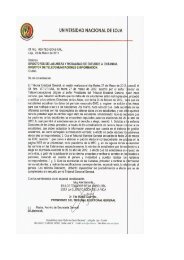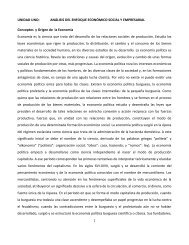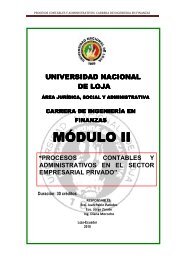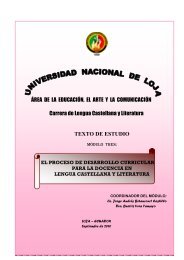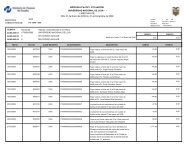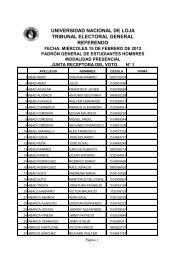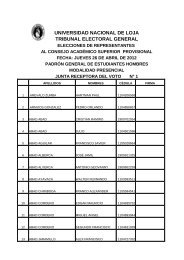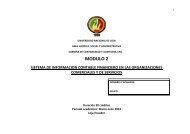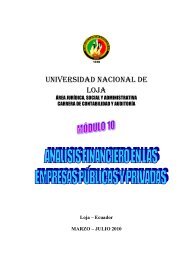module 5 planning of the english language teaching-learning process
module 5 planning of the english language teaching-learning process
module 5 planning of the english language teaching-learning process
Create successful ePaper yourself
Turn your PDF publications into a flip-book with our unique Google optimized e-Paper software.
UNIVERSIDAD NACIONAL DE LOJA<br />
Área de la Educación el Arte y la Comunicación<br />
English Language Career<br />
learners. Grading <strong>language</strong> means choosing to use classroom <strong>language</strong> that is<br />
at or below <strong>the</strong> <strong>language</strong> level <strong>of</strong> <strong>the</strong> learners. For example, with beginners we<br />
use simple words and phrases, but with higher-level learners our <strong>language</strong> can<br />
be more complex. Grading means that our <strong>language</strong> is at <strong>the</strong> right level for <strong>the</strong><br />
learners to understand.<br />
We need to sequence our <strong>language</strong> appropriately to provide learners with<br />
<strong>learning</strong> opportunities. Sequencing means using <strong>language</strong> in a logical order.<br />
This is particularly important for explanations and instructions, for example:<br />
'Listen. Work with a partner.’ ra<strong>the</strong>r than 'Work with a partner. Listen.<br />
Learners can learn classroom <strong>language</strong>, just by hearing it again and again. So<br />
it is important to use <strong>the</strong> same classroom <strong>language</strong> for classroom functions at<br />
<strong>the</strong> early stages <strong>of</strong> <strong>learning</strong>, for example: 'Open your books and look at page<br />
....We can <strong>the</strong>n build up <strong>the</strong>se phrases to suit <strong>the</strong> learners' level and age.<br />
We need to think about <strong>the</strong> <strong>language</strong> we are going to use for different<br />
classroom functions and make sure <strong>the</strong> <strong>language</strong> use is appropriate <strong>language</strong><br />
will use <strong>the</strong> clear. If we do not plan or think about <strong>the</strong> <strong>language</strong> we use, we<br />
might use <strong>the</strong> LI, or <strong>language</strong> which is too complex, which would not be helpful<br />
to <strong>learning</strong>.<br />
FOLLOW UP ACTIVITIES<br />
1. Look at <strong>the</strong> list <strong>of</strong> classroom functions in Key concepts above, and at <strong>the</strong><br />
activities carried out by a teacher below. At which stage <strong>of</strong> a lesson might<br />
you use <strong>the</strong> different classroom functions? You will find that you can use<br />
more than one classroom function at each stage.<br />
Stages <strong>of</strong> a lesson<br />
A. Presenting new vocabulary<br />
B. Telling <strong>the</strong> class a story and encouraging <strong>the</strong>m to join in<br />
C. Brainstorming ideas for a writing task with <strong>the</strong> whole class<br />
D. Monitoring learners during a controlled practice activity<br />
E. Giving feedback after a task<br />
2. Read this teacher's instructions to children on how to make a rabbit (bunny)<br />
puppet. Which <strong>language</strong> form does <strong>the</strong> teacher use for each instruction and<br />
which conjunctions does she use to sequence <strong>the</strong> instructions?<br />
Now watch me first. Take <strong>the</strong> scissors and cut. Start with <strong>the</strong> bunny's head.<br />
OK, be careful. Cut round <strong>the</strong> head and now his big ears ... his big ears that<br />
go flop, flop, flop. And up <strong>the</strong> ear and down again and round his head.<br />
Then, cut here round <strong>the</strong> bunny's face and round his shoulder and down<br />
round his body and now down to his feet.<br />
[Escribir texto] Página 91



